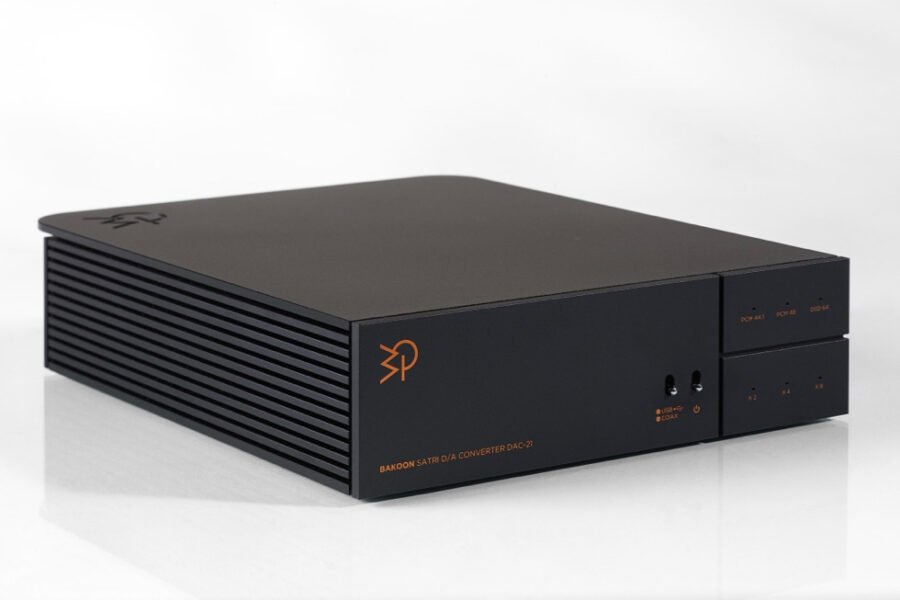The Bakoon Satri DAC-21 D2A DAC is diminutive in size, but does it make up in sound quality what it is lacking in stature? Janine Elliot finds out. I have played with a number of DACs over the years of reviewing hifi, some of which I would actually rather have DUCked from doing if truth be known. The Bakoon is something different; not only is this Japanese/Korean product cute and small, and therefore very unimposing, but it uses a technology I wrote about before with the Questyle QP1r DAP. Using Current Mode Amplification there are distinct advantages over conventional voltage transfer of signals. The latter can be very sensitive to outside noises such as RFI/EMI interference, largely because output impedance is low and the input impedance is high. With Bakoon’s own “SATRI” circuitry supplied from a 5th generation chip on the distinctive purple PCB the reverse happens; the input to the device has impedance very low (around 3 ohms) and with higher output impedance (we’re talking mega ohms), with the circuitry working with the current signals rather than the voltage. Using basic physics, if resistance is negligible then the voltage is converted straight into current. The DAC output stage does not include a conventional OP-amp, rather it takes the DAC chipset’s current signals directly into a SATRI circuit. Although the beginnings of SATRI go back to the 1980’s the first chip only appeared in 1998, a simple epoxy moulding, with SMD dual transistors and carbon resistors. The latest generation has a total of 48 micro-sized transistors, achieving an even higher level of linearity and precision. As well as a conventional RCA output (voltage controlled) the DAC-21 also has a BNC SATRI-LINK (current controlled) output to connect with other Bakoon products (the AMP-51R), and consequently it allows cable runs of 100m with minimal signal loss and RF/EM interference, should you happen to live in a stately home. This will be familiar to Krell owners using their C.A.S.T. technology (Current Audio Signal Transmission) where the connection between components is current based rather than voltage. The DAC-21’s DAC chipset’s current signal enters to the SATRI Circuit, where it is converted to a voltage by the analogue filter network for conventional voltage outputs (RCA), plus the signal is also converted again to current by a set of resistors for the SATRI-LINK output via the BNC sockets.
The DAC-21 is also a zero negative feedback design, which gives it an accurate and fast response with the lowest distortion. On top of this, the Bakoon uses their latest buffer circuitry. What makes the DAC-21 even better is that the design is pure DC, the device running on a total of three internal Li-ion batteries, meaning there is zero noise interference, nor the need for tons of smoothing capacitors. The batteries are recharged in 3 hours for 80% capacity or 6 hours for full charge and give up to 12 hours operating time. The batteries in the Bakoon are controlled fully in the analogue domain, which again reduces noise interference. The power supply which runs the digital, USB, and analogue circuits are controlled independently of each other, which – yes you guessed it – reduces interference. Finally, the circuit grounds of all sections are separated from each other and this reduces that interference further and boosts performance. All in all, nearly four years of development bringing to fruition a product that any company would be really proud, as long as (of course) the audio is just as sound.
The Japanese company Bakoon, run by inventor Akira Nagai, might not be too well known here in the UK but this brand is becoming more international as the years go past. With big sales in Korea it has now become ‘Bakoon International Corp.’, interestingly set up by a South Korean gentleman called Soo In Chae. They now have an R&D centre in Kagoshima, Japan, with their director of engineering Keng Koe Ho (formerly from Sony), and a local corporation in Silicon Valley, USA. This DAC-21 might be mid-price at £2775 + VAT, but it is very high on design features and design engineering. The unit is available in Black, gun-metal or silver. The front panel is very simple; just two switches, one is power off/on and the other is to select between USB and Coax inputs. To the right of these is the now popular idea of six LED lights, the top three to indicate PCM 44.1, 48 and DSD64, and the bottom three indicating x2, x4, and x8. Therefore a DSD256 would indicate “DSD64” plus “x4”, and a PCM 32 bit 384kHz signal would indicate “48” and “x8”. The unit will play up to 32bit/384kHz and DSD256 (Windows) and DSD128 (on a Mac), and whilst the conventional and now popular USB input works a treat, the coaxial input is done via a BNC socket, meaning I needed to get a converter to RCA to operate from my portable DAP. The rear side is well laid out with good connectors, though it is a shame there is no Toslink or AES/EBU connection. There is no reference in the instruction manual to suitable drivers for WIN or IOS, but the website does provide a Windows driver, should you need it (though my Norton security didn’t actually want me to open it). There are two outputs; conventional RCA and also a BNC SATRI-LINK should you have a Bakoon amplifier. Perhaps a disappointment is that there is no volume control, something appearing in many DACs these days, but I didn’t feel this was an issue affecting my judgment of the product. This is a simple featureless product with no need for a remote or toggle on/off switch at the back (hurray!) All it needs is two switches; one for on/off switch and the other to toggle between USB/BNC. USB seems to be the preferred playback system for music files, and so will meet the needs of most audiophiles. If you want Toslink, AES/EBU, balanced outputs or volume control, then you will need to look somewhere else.
This half-width unit is impressively engineered; with straight-lines to the front and sides, but a curvy lip at the rear to hide the cables entering the back. Some might find these looks too conservative compared with a curvy Chord or dCS separate, but it is still a highly stylish but minimalist miniature unit, and the design and build reminded me of Nakamichi’s penchant for straight lines. Only the thin felt feet are an afterthought, unlike the massive stilts holding up their larger and impressive AMP-51R SATRI amplifier, which also interestingly work as additional heatsinks. It did mean I needed to add my own KM Sounds ceramic isolating feet to raise it above the unit on which it was sitting at the time of the review.
It’s always in the Name
I always like to examine the names of manufacturers and their products as it often enlightens me as to what is going on in the minds of the designers. Imported into the UK by Martin Gateley from SoundKaos (whose company name and “Liberation” speaker, recently reviewed in HiFi Pig, gave insight into what he was aiming to do in that product), it is equally the case here with Bakoon. A Baku is a supernatural creature from Japanese mythology associated with dreams, and the word Un means ‘luck’. Whilst ‘lucky Dreams’ would probably be more suitable as a manufacturer of mattresses, the term ‘SATRI’ means “Enlightenment”, and I was certainly educated whilst listening to my prized digital files; a sense of detail and precision that gave me new insights into much of the music I played through it.
The Music
This is no Baboon, but nor is it anaemic in its portrayal of the music. The output into my Krell/MFA amplification was very quick and controlled; this animal was being very well behaved. Nothing stuck out either as OTT or conversely missing. I did wonder if the unit would cause me problems working for 12 hours and then needing to be charged for at least another three, but this was no less inconvenient than the portable DAP and DAC I use
Initial listening was from 1bit DSD256 recordings I had obtained. The Dvorak New World Symphony was clear, if not a bit clinical, though the depth between instruments front and back was delivered with startling realism. This recording was a simple coincident pair of microphones, void of complex multitrack mixing, which often makes things less musical particularly in the digital domain. The Bakoon had a great deal of warmth and emotion sounding less ‘digital’ than many DACs at a higher price. Turning to Wagner’s The Flying Dutchman (Netherlands Philharmonic Orchestra, Yakov Kreizberg) the music was forceful but well controlled, as Wagner should be. I only wish I could have used the SATRI output into a Bakoon amplifier, but the quality did not suffer at all. The design means for a very quiet operation however it is connected, and clarity and analogue finesse missing in many DACs.
The attention to detail in the music is met equally in the metalwork, something typical of South Korean audio products particularly their DAPs, and in the use of components, including the inclusion of an ESS Sabre ES9018S chip. As well as a very simple operation using the machine, the charging is just as well thought out; the three white LEDs at the top start to blink when the battery level is low, and the unit will automatically turn itself off. The circuitry also determines which of the three battery packs, positioned on the underside of the purple PCB, need to be charged. The charging will only start when the power switch is turned off, though I did feel it a pity that it couldn’t just do it automatically, though of course such a feature might have affected the sound. To show the state of recharging of the batteries the three lower white LEDs change to red lights, and only turn off one by one when fully charged.
As well as USB and DAP sources I also decided to use the digital output of my loved antique Philips DCC900, playing Gershwin “An American in Paris” (Andre Previn/Pittsburgh Symphony Orchestra). This might well be highly compressed audio, but the clarity and sense of control make this a very enjoyable and surprising listen for me. ESS DACs can at times sound rather “digital” and lack realism that is abundant in analogue reel to reel and vinyl, but what the Bakoon does is bring in a very natural realism into the music. Listening to Van Morrison Avalon Sunset “Whenever God Shines His Light” showed not only the clarity, speed, and separation of all instruments, giving a good wide soundstage, but also that the DAC-21 is very sensitive to vocals, even to Cliff Richard’s voice pairing with Van in this toe-tapping track.
Turning to USB and Nirvana 96/24bit remaster “Smells Like teen Spirit” from the album (Nevermind), suddenly all let rip as if the DAC had just woken up. However, it didn’t sound as brittle as it can from other DACs I have tried. “In Bloom” bloomed with boisterous bass drum and sizzling cymbals, but less digitised as I have heard it. The bass is extremely well catered for in the DAC; plenty of energy when needed, but never ‘over the top’. Mid voices are also clear and fast.
Conclusion
This is a well thought-out unit, with many years going into its design, which ultimately works its way through to the music it plays. Music has sensitivity but also emotion, clarity, and determination, nothing is too much and nothing missing. However at £2775 + VAT there is great competition out there, so it is well worth auditioning along with a few other designs in this price point. I wasn’t able to use it with their SATRI amplifier, but there were no issues with noise or interference, as I wouldn’t expect to hear in my well-designed music room, so this will work very well with any amplifier. Being small means you could fit more audio into your shelving, which could be a good or bad thing.
Build Quality: Good looks, an excellent minimalistic design only as big as it needs to be. No screws or joins to spoil the looks. Very well put together.
Sound Quality: Clean sound, will good bass and vocals.
Value for Money: At £3260 including VAT this is in the mid-range for DACs. It certainly warrants this price but worth listening to other DACs at this price to decide your ideal partner.
Pros: Design and SATRI system ensure well controlled and pure sound at long cable runs, with minimal EMI/RFI
Dynamic and detailed, with excellent bass and mid-range.
Minimalist and clean looks.
Cons :Only 2 input choices
No balanced output
Price: £3260
Janine Elliot










































































































































































































You must be logged in to leave a reply.